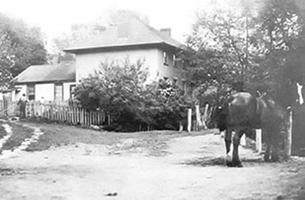This content is from a series created in partnership with Museum Services of the City of Toronto and Heritage Toronto. We gratefully acknowledge funding from the Ontario Ministry of Tourism, Culture and Sport, and the Department of Canadian Heritage.
Toronto Feature: Todmorden Mills
"Remnants of Toronto's Oldest Mill Site on the Don River"
With the growing need for lumber in the expanding settlement of York in 1793, Lieutenant-Governor John Graves Simcoe granted land on the Don River to Aaron and Isaiah Skinner for construction of a sawmill. The next year he directed that "a pair of mill stones and a set of grist mill irons" be provided to the Skinners. By 1795 they had added a grist mill and by 1823 Thomas Helliwell added a brewery, distillery and second grist mill. The site became known as the Don Mills.
Colin Skinner, the son of Isaiah, had inherited and purchased much of the Skinner property and sold two-thirds of it to Thomas Helliwell and John Eastwood in 1820. Their partnership, which ended in 1822, was to completely change the area. In 1822, Thomas Helliwell renamed the village Todmorden after his family's hometown in England and by the 1850s the mills were called the Todmorden Mills.
The Helliwell house still stands, a rare example of an adobe mud brick home in Toronto. A fire destroyed the brewery in 1847; by 1855, the Helliwell family had gradually sold their land and businesses to the Taylor family, who operated three paper mills on the Don River--the source of the first machine-made paper in Upper Canada.
A prisoner of war camp (see internment) was set up across the river from Todmorden Mills during the Second World War. The prisoners often worked in the nearby Don Valley Brick Works (see Evergreen Brick Works), which had been established by William Taylor. East York mayor True Davidson proposed the conversion of the site into a museum as a centennial project in 1965. Todmorden Mills opened as an historic site in 1967. The centennial symbol remains prominently displayed on the top of its brick chimney, a lasting landmark visible from the Don Valley Parkway.

 Partager sur Facebook
Partager sur Facebook Partager sur X
Partager sur X Partager par Email
Partager par Email Partager sur Google Classroom
Partager sur Google Classroom





